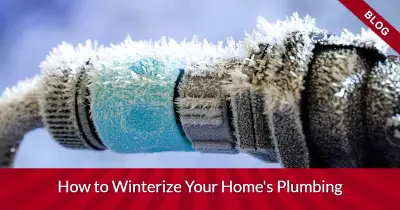 All of the leaves have fallen and snow is starting to take their place, which can only mean one thing... winter is coming fast.
All of the leaves have fallen and snow is starting to take their place, which can only mean one thing... winter is coming fast.
One of the things most homeowners don't consider is how the harsh Regina winters can take a toll on the pipes in your home.
The water in your pipes will freeze, at which point the ice will expand and cause stress on your pipes that may lead to them bursting... Then you're left to pay thousands of dollars to replace them.
However, you can winterize pipes to ensure a safe winter for all your piping (and for your wallet). Here are 10 tips to do just that and get yourself in a good spot for the cold months ahead.
1. Contact Your Friendly-Neighbourhood Plumbing Expert
Before doing anything else to winterize your piping you should first have it inspected for the upcoming winter months.
They can ensure that everything is clean and ready for the next several tips below.
If there is something that needs to be taken care of, they can schedule to do that before the temperature gets too low.
Now you can rest assured knowing your pipes are clean as a whistle and prepared for what's ahead.
2. Outdoor Faucets
Every outdoor faucet has a shutoff valve located in its piping, you're going to want to shut it off for the winter.
However, before you do that, make sure to drain any remaining water out of it to avoid said water freezing and causing problems during the cold months.
Just leave the bleeder cap open and let the water drain with a bucket underneath it.
After it's done, turn the faucet off, and don't worry about it again until the spring birds arrive.
3. Insulate the Pipes
The best way to avoid your pipes freezing mid-winter is through frozen pipe prevention practices.
Insulating your pipes will help any water inside the pipes from feeling the temperature fall below freezing. It will also help protect the pipes from cracks at the same time.
Find some fiberglass that you can wrap around the pipes to regulate the temperature. this is the best way to make sure it stays as close to a normal temperature as possible.
4. Disconnect All Hoses
Now that there’s snow on the ground and freezing temperatures, there's no reason to keep the hoses out.
In fact, if you leave it connected to the faucet then the ice the hose builds will lead back into your home's piping.
Disconnect all of them, make sure all of the water is out of them, and then place them away in your garage for a few months.
5. Cover Hose Spigots
While you're messing with the outdoor hoses you should also consider the toll winter will take on your hose spigots (where the hose connects to).
Any built-up ice from the spigot can still lead back to your pipes and cause freezing and cracking.
To prevent that from happening, buy some spigot covers for insulation where your pipes may need it most. Otherwise, you risk the cold by having easy access to the plumbing inside your home.
6. Let Your Faucet Drip
Although we wouldn’t recommend this, if you are faced with an emergency situation you can decide to let your faucet drip overnight.
Since the nighttime is when those winter temperatures will fall the most - keeping a dripping faucet will keep the water moving and less likely to freeze.
It will also help get rid of any pressure between frozen water and the pipes, which will help it refrain from expanding to the point of bursting your pipe.
7. Seal the Vents
Now it's time to make sure the cold doesn't enter in from your ventilation that leads outside.
To do that, find some cardboard (that can sustain the winter itself) and duct tape it over the vents.
While it may seem exhaustive, this will help you attempt to regulate how much cold air is coming into your home. Speaking of...
8. Quarantine the Basement
Okay... maybe the paragraph title is a bit dramatic. However, you will want to make sure to protect your basement from the outside cold as much as possible.
Anything from a tiny crack in a window to some faulty (or absent) fiberglass around the walls can allow the cold to come in and compromise your piping.
Think through any possible crawl spaces or windows that could bring the cold in and make plans to eradicate it.
9. Get a Heat Cable
Many experts in the plumbing industry would recommend that you purchase and install a heat cable into your home.
The cable will monitor all the temperatures of your pipes and trigger the heat off and on to help regulate the pipes' temperatures.
This may be one of the best ways to prevent frozen pipes altogether. The cable is cost-effective and will help protect your pipes from costing you thousands of dollars.
10. Open Cabinet Doors
The very thing that prevents you from looking at pipes around your house all day could be the same thing preventing it from staying as warm as possible.
Opening your cabinet doors every so often will help provide more heat to the pipes and keep them at a manageable temperature.
Winterize Pipes with a Local Expert
If you're in the Regina area and looking to winterize pipes in your home, contact Mr. Rooter Plumbing of Regina to get the process started. Our professional and courteous technicians will walk you through every step of the way.
If you enjoyed this blog, be sure to read this article on what running out of hot water quickly may mean for your home’s plumbing.
For more plumbing & drain cleaning inquiries or service needs, head over to our contact page or call us today for prompt service!

